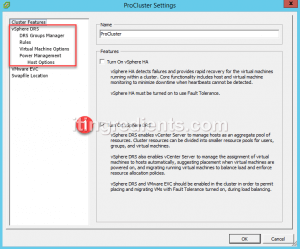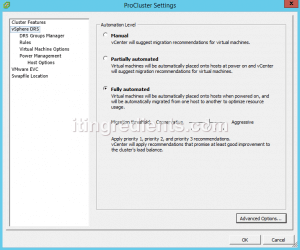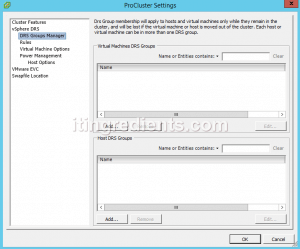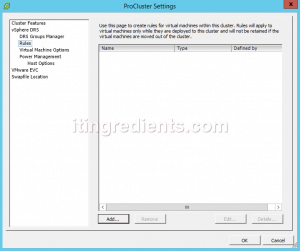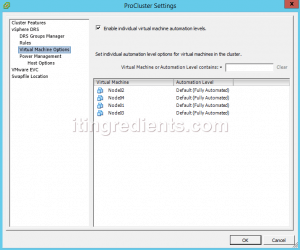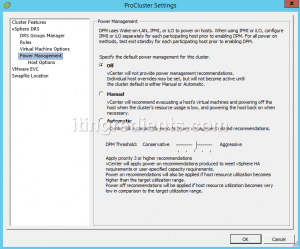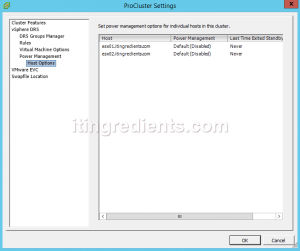How to enable VMWare Distributed Resource Scheduler (DRS)
How to enable VMWare Distributed Resource Scheduler (DRS)
In this post, we’ll learn the steps to enable VMWare Distributed Resource Scheduler on vCenter Server 6. Vmware Distributed Resource Scheduler is used to automated load balance computing capacity to deliver optimized performance for hosts and virtual machines. Once Distributed Resource Scheduler is configured it automatically manages the load of ESXi Serves. DRS hot migrate the running Virtual Machine from over loaded VMWare ESXi host to another less loaded VMWare ESXi host without disrupting services (steps to configure vMotion). It’s a great feature that helps in reducing management efforts of monitoring and managing infrastructure.
DRS also gives you an option to define affinity and anti-affinity rules which tells the vSphere hypervisor environment to either keep virtual machines together or host them on separate hypervisors. Before we enable VMWare Distributed Resource Scheduler (DRS), please ensure that a VMWare Cluster is created and we have more than one ESXi servers in that Cluster. In addition to that, please ensure that vMotion is configured and all the Virtual Machines are hosted on Shared Storage.
Steps to enable VMWare Distributed Resource Scheduler (DRS)
Step 1:
Login to vCenter Server 6.
Right click on Cluster name and select “Edit Settings”.
Step 2:
On the Cluster settings window, turn on “vSphere DRS” option. It would enable vSphere DRS.
Step 3:
Click on the “vSphere DRS” option to define the automation level. Automation level would give an option to either automatically define the placement of Virtual Machines on the VMWare ESXi hosts or suggest migration recommendation for Virtual machines. You can select them as per your environment.
a) Manual automation level: This option would suggest migration recommendation for Virtual machines.
b) Partially automated: This option would automatically place Virtual Machines on hosts at power on and would suggest migration recommendations.
c) Fully automated: This option would automatically place the Virtual Machines on the least loaded ESXi Servers.
You can even define the migration threshold as conservation or aggressive.
Step 4:
Click on “DRS Groups Manger“. It is used to define Virtual Machines DRS Groups and Host DRS Groups.
We’ll not define any DRS groups, we’ll talk about these options in future tutorials
Step 5:
Click on Rules to define affinity and anti-affinity rules that we talked earlier.
We’ll explain affinity and anti-affinity rules in future posts.
Step 6:
Click on “Virtual Machine Options“. This option is to define automation level at the Virtual Machine level.
Either we can use the default “Automation Level” that is defined for the cluster or define individual automation level for all the Virtual machines.
Step 7:
Click on “Power Management” to specify power management for ESXi Servers.
Some of the options that we can see for Default Power Management options are Off, Manual and Automatic.
Automatic option will automatically execute power management related recommendations.
Step 8:
Click on “Host Options” to define power management options for individual hosts.
Default power management option is disabled. You can select the same as per your requirements.
Click on OK and this would enable Distributed Resource Scheduler.
Step 9:
To check DRS functionality, we have moved all the Virtual Machines i.e. Node01, Node02, Node03 and Node04 to ESX01. All the Virtual Machines are in powered off state.
We powered on Node01 and it placed on ESX01.
Then we powered on Node02 it automatically moved to ESX02. This confirms that Distributed Resource Scheduler is enabled and working properly.
Then we powered on Node03 and it placed on ESX01.
Then we powered on Node04 and it automatically moved to ESX02.
Now we have Node01 and Node03 running on ESX01 and Node02 and Node04 running on ESX02. If we try to place Node02 on ESX01 then it would automatically push some of the VMs from ESX01 to ESX02 to manage the load.
Hope you understood the steps to enable VMWare Distributed Resource Scheduler using vCenter Server 6. Feel free to leave your comments and suggestions in the comment section.



